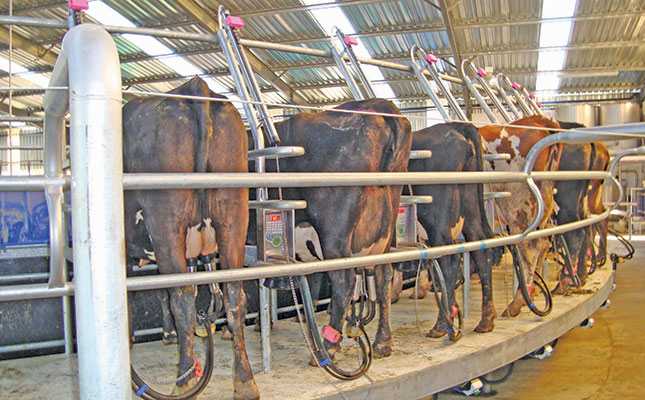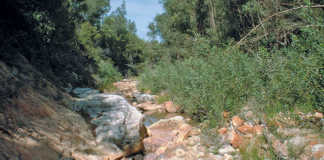
Photo: FW Archive
Three-day stiff sickness (TDS), also known as bovine ephemeral fever, is a viral disease in cattle that is transmitted by midges and mosquitoes.
The Culicoides midge (also responsible for the transmission of bluetongue in sheep and African horse sickness in equines) and Anopheles mosquito are the primary vectors of TDS. The disease cannot be transmitted via direct contact.
While mortality is low (generally less than 1%), TDS can have a severe impact on livestock production. For example, cows in advanced stages of gestation may suddenly abort, and milk production in dairy cows may decline significantly. TDS may also have a temporary effect on the fertility of bulls.
Infected animals may experience a sudden onset of fever (40°C to 41°C). They also experience muscle stiffness (hence the name), lie down and are reluctant to stand up or move around. The fever usually breaks, with the temperature returning to normal, within 36 hours.
The disease is seasonal and occurs throughout South Africa. As the insect vectors proliferate after rain, there may be more frequent TDS outbreaks after periods of above-average rainfall.
TDS is primarily an inflammatory disease, and clinical signs and symptoms are a vascular inflammation response to infection. TDS causes damage to minor blood vessels of the tendons, muscles, joints and skin, and can result in permanent paralysis. This paralysis can be likened to that experienced by cows with milk fever.
An animal’s potassium, iron and zinc levels also decline dramatically.
Symptoms
The disease can present as mild, moderate and serious. Cattle that have recovered from TDS usually develop immunity to the disease, and rarely become infected again.
Mild cases
An animal with a mild case of TDS is stiff and lethargic, and may have a fever for a short period of time. As mentioned earlier, it may be reluctant to move, and may stop eating and drinking. Milk production can decline by between 10% and 95%, or may cease altogether. Cows may also develop subclinical mastitis.
Animals usually recover from mild TDS within two or three days. Despite a fairly quick recovery, most affected cows may never return to their original level of milk production.
Moderate cases
An animal with a moderate case of TDS may separate itself from the herd and stop eating. As with the other levels of TDS infection, the animal will display stiffness, and may exhibit muscular tremors and lameness that shifts from leg to leg.
There may also be eye and nasal discharge, excessive salivation, and swollen joints. Bulls may become temporarily infertile, producing abnormal sperm for between three and six months. And while permanent infertility does occur, it is rare.
Serious case
An animal with a serious case of TDS will lie on its front and refuse to get up. Degeneration of the spinal cord leads to permanent paralysis. As the animal lies down for an extended period, it may develop pressure sores or even contract pneumonia.
The animal is unable to swallow and may become bloated, and as its rumen activity comes to a halt, it will also become constipated. It may also salivate excessively, and often rests its head on its flank.
An animal with a serious case may also change from lying on its stomach with its head up, to lying on its side. As reflex action ceases, the animal will fall into a coma and eventually die.
In a small proportion of cases emphysema develops in the lungs, and subcutaneous emphysema (accumulation of air) in the back and other parts of the body. This is referred to as atypical TDS.
Diagnosis
Based on the animal’s symptoms and the season of the year, a veterinarian will be able to make a provisional diagnosis. Blood samples may indicate the presence of virus antibodies, suggesting possible infection. An elevated white blood cell count may also indicate infection.
The diagnosis can only be confirmed, however, by examining the effect of the virus on body tissue, as seen under an electron microscope.
Treatment and prevention
If you suspect that one of your animals may be infected with TDS, it is essential that you consult an animal health technician. The reason for this is that TDS can be misdiagnosed by a non-professional, as it presents with symptoms similar to those of other diseases or illnesses (see Differential diagnosis box). Treatment is symptomatic.
An animal with TDS should have sufficient rest, and must be protected from the heat, wind and cold. Provide the infected animal with clean, fresh water and feed that can be easily accessed at all times.
Since an animal with TDS may be less inclined to eat and drink, it is important to ensure that it remains hydrated. Since TDS is primarily and inflammatory disease, anti-inflammatories can be used to help ease an animal’s pain and clinical signs of the disease. Calcium, zinc and iron can also be administered.
If animals are struggling to swallow, do not administer liquid by mouth, as they may choke. Give the relevant medication to an infected animal that is constipated in order to stimulate the rumen.
Animals should be vaccinated against TDS every year. Onderstepoort Biological Products produces the live-attenuated vaccine B-Phemeral, which should be injected subcutaneously. Calves of vaccinated cows will receive protection against TDS from their dams until the age of around six months.
As TDS is transmitted via biting insects, spraying cattle with insect repellent may prevent bites. Mosquitoes and midges breed in water, so grazing cattle away from standing water may also help to prevent transmission. These insects are most active after dusk, so avoid overnighting cattle near well-watered areas or alongside dams.
Three-day Stiff Sickness in South AfricaThe first recorded outbreak of TDS began in north-west Zimbabwe in November 1906. From central Zimbabwe, the disease moved in a southerly direction to reach what were then the Transvaal and Natal by March 1907. By the end of that year, cases were reported near Port Elizabeth. “Although transmission by birds associated with locust plagues was originally proposed, biting midges were subsequently implicated by analogy with bluetongue disease,” write researchers Peter Walker and Eyal Klement. “Major [outbreaks] were subsequently reported in South Africa in 1949, 1953 to 1955, 1966 to 1968, 1974, and 1981 to 1984.” Walker and Klement further write that the epizootic of 1953 to 1955 was particularly severe, with mortality rates approaching 30% in some herds. “TDS is now reported to occur regularly in South Africa from the northern border to the southern coast. Clinical disease occurs less frequently in some districts, and the severity and extent of outbreaks may vary from year to year. The disease typically appears in late summer, but can occur earlier in the winter rainfall region of the Western Cape. It has also been reported to occur annually in Namibia, albeit later than in South Africa, with outbreaks sometimes extending into winter.” |
Source: Walker, PJ and Klement, E. 2015. ‘Epidemiology and control of bovine ephemeral fever’. Veterinary Research. 46(124). FW











